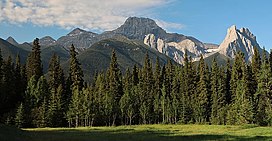|
Mount Lougheed
Mount Lougheed is a 3,107-metre (10,194-foot) triple-peak mountain located between Spray Lakes Reservoir and the Wind Valley of Kananaskis Country in the Canadian Rockies of Alberta, Canada. The highest summit is known as Peak 2 (3,107 metres). Peak 1 to the northwest is 3,080 metres.[4] Peak 3 to the southeast is 3,010 metres.[5] The nearest higher peak is Wind Mountain, 2.0 km (1.2 mi) to the southeast.[1] Mount Lougheed is a conspicuous landmark that can be seen from Highway 1, the Trans-Canada Highway at Dead Man's Flats which is east of Canmore. HistoryMount Lougheed was named after Sir James Lougheed (1854–1925), a prominent lawyer, politician, senator, and cabinet minister.[1] The mountain was originally named Wind Mountain by Eugène Bourgeau of the Palliser expedition, but was renamed in 1928 to honor Lougheed after his passing.[1] The mountain's name was officially adopted in 1928 by the Geographical Names Board of Canada.[2] The first ascent was made in 1889 by A. St. Cyr, W.S. Drewry, and Tom Wilson.[1] Mount Lougheed was the scene of the second of three related airplane crashes known as the Rescue 807 Crashes. GeologyMount Lougheed is composed of Palliser limestone, a sedimentary rock laid down during the Precambrian to Jurassic periods.[6] Formed in shallow seas, this sedimentary rock was pushed east and over the top of younger rock during the Laramide orogeny.[7] ClimateBased on the Köppen climate classification, Mount Lougheed is located in a subarctic climate zone with cold, snowy winters, and mild summers.[8] Temperatures can drop below −20 °C with wind chill factors below −30 °C. Precipitation runoff from Mount Lougheed drains into the Bow River which is a tributary of the Saskatchewan River. GallerySee alsoReferences
External links
|
||||||||||||||||||||||||||||||||||||||||||||






